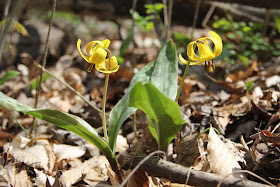The park is located on the north side of Mt. Pleasant at 1458 N. Harris Street (Crawford Rd.). The park measures 60 acres in size, with the majority of the park being wooded and undeveloped. The north and east edges of the park are mostly swamp. This is where I like to spend my time.
Skunk Cabbage (Symplocarpus foetidus) is one of my favorite subjects to photograph. Its flowers are mostly done for the year and beginning to develop seeds.
The large leaves of the skunk cabbage give the plant its name. They do indeed look like cabbage leaves and they smell like a skunk when crushed or broken. The leaves are just now emerging from the muck of the swamp, but will reach eventually grow to be as much as 1foot wide and 2 feet long. Sections of this swamp will be completely covered with the leaves.
I love how the immense size of the skunk cabbage leaves contrast with just about any other plant such as these sedges.
Right now the swamp is also full of Marsh Marigold (Caltha palustris). Their yellow flowers certainly brighten up the overall green color scheme of the swamp.
I never got close, but I saw a Red Admiral (Vanessa atalanta) butterfly feeding on Marsh Marigold nectar. It looks like its going to be a big year for Red Admirals - they are everywhere.
One edge of the swamp was covered with the small white flowers of Spring Cress (Cardamine bulbosa).
Spring Cress requires a little bit drier soil than either Skunk Cabbage or Marsh Marigold. Many of the Spring Cress plants were growing on clumps of sedge. It is amazing how a change of a few inches can influence the types of plants that can be found.
In drier areas of the park I found dozens of Yellow Trout Lilies (Erythronium americanum). This seems to be a good year for finding trout lilies - a friend sent me a photograph showing at least twenty flowers in an area of probably less than 3 feet by 3 feet. Unlike many other spring wildflowers, trout lilies do not bloom every year. Producing a flower takes lots of energy and it takes each plant as much as 7-10 years to store up enough (in the form of sugar) to be able to create a flower.
I found a few Bloodroot (Sanguinaria canadensis) flowers in bloom. These plants typically only flower for a day or two. Once pollinated they begin to lose their petals within hours. My Bloodroot plants at home have been done flowering for a week.
Bloodroot is one of many spring wildflowers that are spread by ants. Each Bloodroot seed has a fleshy coating known as an eliaosome; ants like to eat this coating. They harvest the seeds and carry them back to their tunnels where they eat the eliaosome before depositing the seeds in their garbage piles.
I also found many hundreds (probably thousands) of Spring Beauty (Claytonia virginica) flowers in bloom in the drier areas of the park.

















































